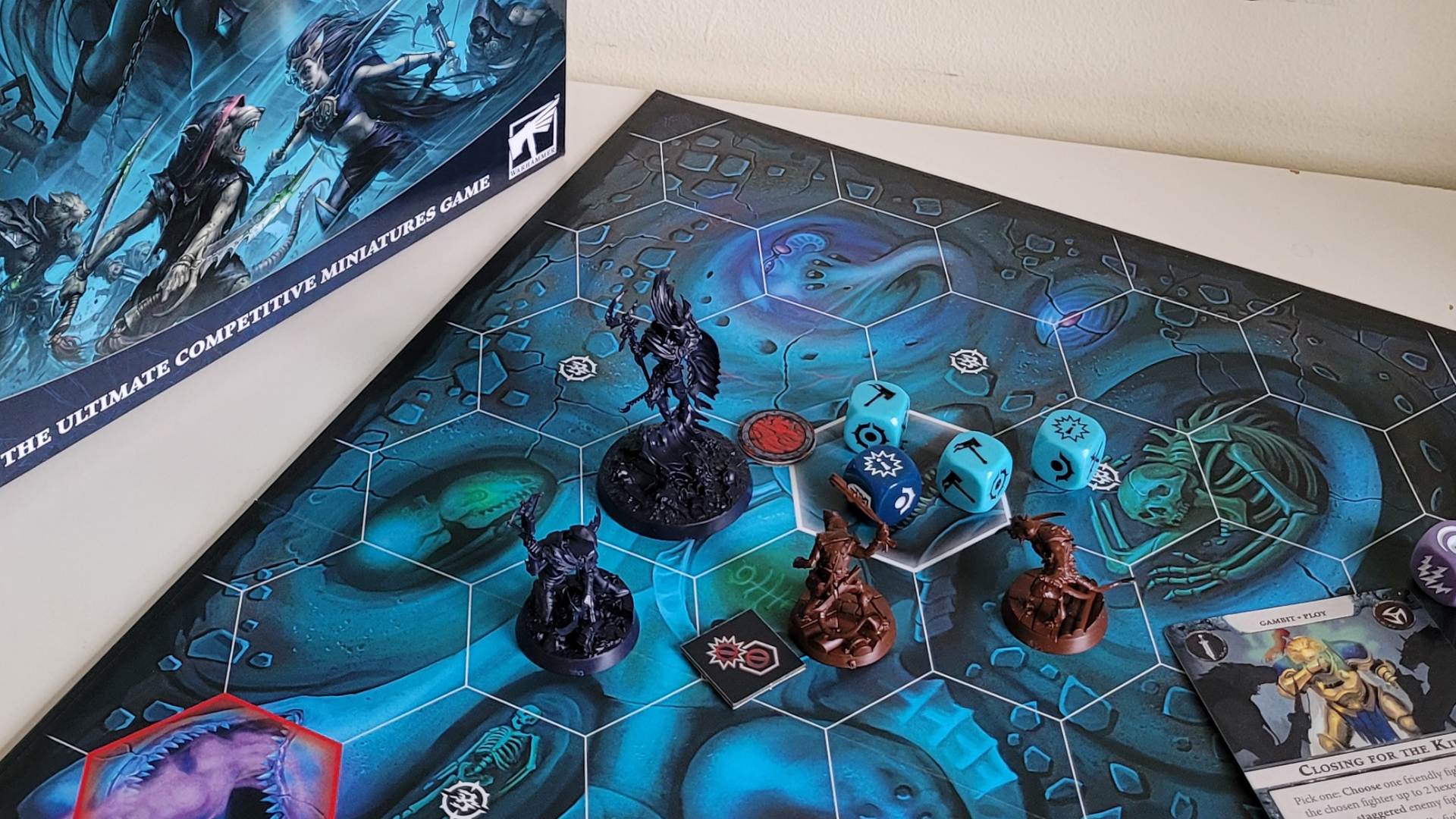GamesRadar+ Verdict
Warhammer Underworlds: Nethermaze is a robust and exciting addition to the franchise. Yes, its miniatures are fiddly to build... but they look spectacular on the tabletop. There's also plenty of gameplay variety in the box to fuel long-term strategies; while it can be a bit overwhelming for new players, fans will appreciate what it can offer.
Pros
- +
Fast, exciting skirmish system that rewards good planning and clever play
- +
Lots of variety in the box and potential for long-term strategy with customised decks
- +
Looks absolutely spectacular on your tabletop
Cons
- -
Miniatures are very fiddly and fragile for a board game
- -
Steep learning curve for what is now a mature, long-running franchise
- -
Quite a lot of luck involved despite strategic considerations
Why you can trust GamesRadar+
Games Workshop has a long tradition of releasing single-box board games of varying quality, and then not always supporting them as much as we might like. So it says a lot about the popularity of Warhammer Underworlds that it’s become another core line for the company, behind Age of Sigmar and 40K. And why wouldn’t it? It’s a great series that you can paint and play in a fraction of the time of its bigger siblings.
Now that we're a few entries in, the publisher has changed the release schedule so there are more core boxes and less expansions. Nethermaze is the latest core box, and the first since they upped the frequency. How does it compare to previous entries like Warhammer Underworlds: Harrowdeep?
What is it, and how does it work?

- Game type: Skirmish wargame
- Players: 2
- Complexity: Moderate
- Lasts: 30 - 60 mins
- Ages: 12+
- Price: $95 / £65
- Play if you enjoy: Age of Sigmar, 40K, Kill Team, Warcry
Warhammer Underworlds: Nethermaze is a tight skirmish game between two warbands where each player only gets four actions per turn (move, attack, guard, or charge) over the course of three turns, making it fast to play and action-packed.
It's not just about manoeuvres and rolling dice to hit, though; players also have two decks of cards to contend with. One is for objectives, which contains cards that can be played if certain conditions are fulfilled to score points. The other is a power deck, which contains a mixture of one-shot effects and upgrades that you can attach to members of your warband.
The goal is to claim territory and win the game, after all, not necessarily to survive
Strategy actually begins during setup, too; you have a choice of how the two modular boards will sit together, where potential objective hexes will go, and where you'll place your fighters. Once the action is underway, a fighter has a choice of four actions. One can be a move, after which they cannot move again. They can also take attack actions to strike at enemy figures, or guard actions to protect themselves. The final choice is 'charge', a combination of attack and move which leaves the figure unable to take any further actions that turn.
Similarly, attacks aren't just resolved via dice roll. Yes, the basics remain familiar. The number of dice rolled by the attacking figure and the symbol needed to hit - with some being more common than others on this custom die - are listed via the unit’s card, and successes on the attack dice are cancelled out by blocks on the defence dice. But in a clever twist, there are additional symbols on both kinds that can be counted as a success if there’s another friendly adjacent figure. And while most figures have to be adjacent to their target on the hex board, some have ranged attacks or spells that use a different set of dice altogether.

Throw in a number of special keywords that can enhance attacks and power cards that are able to help with attack or defence and you've got a fairly novel system.
Weekly digests, tales from the communities you love, and more
So, why are you doing this? It's all for the glory - quite literally. Successful attacks inflict wounds, and if the target suffers enough damage, that figure is removed and their opponent gets a 'glory' point. Objectives gain you even more points, and many require your fighters to behave semi-suicidally to gain them. The goal is to claim territory and win the game, after all, not necessarily to survive.
However, it's not always a case of doom and gloom. While points are crucial for victory, they're also a prerequisite for buying upgrades.
Gameplay

Nethermaze is the latest box in what is now quite a mature series; the first set, Shadespire, was released back in 2017. It’s kept going this long because it is very good indeed, a gleeful mixture of strategy, tactics, and luck packed into a taut setup where mistakes or bad dice rolls can swing things back and forth with astonishing speed. Games often come right down to the wire. There is a lot of randomness which may put off more considered players, but even if one side has an absurd run of luck and wipes the other off the board, the half-hour play time makes it easy to re-rack and go again.
Nethermaze keeps up that tradition.
The action and support system intertwine to make manoeuvre on the board full of difficult choices. Often you’ll want to charge in order to get stuck in to the enemy as quickly as possible. But if you do, that’s essentially the end of that figure’s turn and if their target survives - which is likely on an initial attack - they can strike back repeatedly. Worse, another figure might get moved up in support, swinging the odds of each dice roll in their favour. So it’s all about jockying for position, trying to get in sudden, card-supported strikes, and ganging up where possible.
You can have a great time with the included cards and pre-built decks
At the same time, you’ll need to watch your cards closely. Winning individual fights is only half the battle. You also need to set up situations that let you make the most of power cards or score objective cards. The latter sometimes have nothing to do with even fighting, let alone winning, but can score you points for taking particular hexes or infiltrating onto the enemy board. Players draw up at the end of the three, brief turns, so it’s critical you play as many cards as possible to avoid wastage. So you’ll need to spend model activations just as much on achieving objectives as on taking out the enemy. Finding the right balance is crucial.
Those more interested by long-term strategy can ditch the pre-built “rivals” decks that come with the game and build their own. There are some additional cards included in the box that you can do this with, but the real pleasure here is from the wider Underworlds series which features many expansion warbands and other core sets. If you buy in, you’ll soon have a huge collection of cards to build with. But it’s important to emphasise that you don’t need to: you can have a great time with the included cards and pre-built decks, using Nethermaze purely as a straightforward board game for 2 players.

It's not all rosy, though. Nethermaze doesn’t add much apart from the new boards, figures and cards it contains. There are a couple of new card keywords, most interestingly 'domain' cards which affect the whole board until they’re replaced by another 'domain'. But it also has a couple of minor problems. As the system has accrued detail over the years, it’s become more complex and now has quite a steep learning curve. If that puts you off, there’s a special starter set, a separate box, that serves as a gentler introduction. The next new box in the series, Gnarlwood, has promised a split into standard and advanced rules to make it easier. But in Nethermaze, you’re stuck with a monolithic rulebook and quite a lot of look-up time that risks slowing down the action.
The other issue is more subjective. The two warbands that come with Nethermaze are both assassins, one of rat-like Skaven and the other of graceful Aelves. They’re incredible sculpts, packed with detail and fluid with movement that look absolutely superb against the blues and purples of the rich board art and dice. But despite what the box back says, they’re not easy to build at all and are more suited to experienced modellers. They’re fiddly to put together and very fragile, with lots of small protrusions that break easily. Some of them feel more like display pieces than something you’d handle as part of gameplay.
Should you buy Warhammer Underworlds: Nethermaze?
Because Warhammer Underworlds is an ongoing series, a recommendation will depend on your experience with the ecosystem. Regular players will find a lot to enjoy here. While there’s not much new in the rules, there are lots of good cards and they’ll presumably be happy to deal with the complex but stunning models. In much the same way, hobby gamers can probably jump in at this level of complexity and Nethermaze is a good set with plenty of variety. As for more cautious neophytes, on the other hand? Well, they might be better off with the official Starter Set or one of the older boxes, if they’re still available.
Whichever way you jump, Underworlds as a whole is great fun, one of the best skirmish systems on the market, and very much worth your time.
How we tested Warhammer Underworlds: Nethermaze
This board game was tested thoroughly in multiple hands-on matches over a number of days, and I spent time putting together all of the models contained within the box to test how easy they were to construct.
To find out more about how the site handles tabletop critique, check out our guide on how we test board games and tabletop RPGs at GamesRadar+.
For more tabletop recommendations, don't miss these board games for adults, the best cooperative board games, or our suggestions for must-have party board games.

Matt is a freelance writer specialising in board games and tabletop. With over a decade of reviews under his belt, he has racked up credits including IGN, Dicebreaker, T3, and The Guardian.



